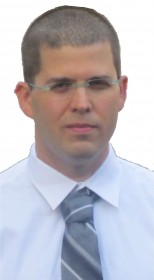
VASC Seminar
November

3:00 pm to 4:00 pm
Event Location: NSH 1305
Bio: Dov Katz is a postdoctoral fellow with the National Robotics Engineering Center at Carnegie Mellon University. His research interests include autonomous manipulation, computer vision, and machine learning. He received his MS in 2008 and Ph.D. in 2011 from the University of Massachusetts Amherst, and his BS in 2004 from Tel-Aviv University, Israel. He was a recipient of the Yahoo! Outstanding masters thesis award and Tel-Aviv University’s distinguished undergraduate research award. He passed the UMass Amherst PhD portfolio with distinction, and was best manipulation paper finalist at ICRA 2008. His work has received attention in popular press, including the discovery channel and Wired Magazine. He is the founder and co-chair of the IEEE/RAS technical committee on mobile manipulation.
Abstract: From the early days of the Shakey project, autonomous manipulation has been concerned with building robots that perform general tasks in general environments. Because of the challenges associated with autonomous manipulation, researchers adopted the sense-plan-act paradigm, effectively decomposing the field into disciplines such as computer vision, control, motion planning, and machine learning. Unfortunately, after several decades of tremendous progress in each discipline, we have seen only little impact on the original problem of autonomous manipulation.
I believe that this lack of progress is because manipulation problems can rarely be decomposed along the above academic disciplines. In my work, I propose to rethink this decomposition. Instead of solving problems by defining interfaces between sensing, planning, and acting, I propose to explore and exploit the interactions between these subfields. The result is a task-specific decomposition of manipulation problems: action, perception, and planning do not interface sequentially, but instead interact with each other. I will demonstrate this principle on two problems: manipulating articulated objects and pile manipulation.